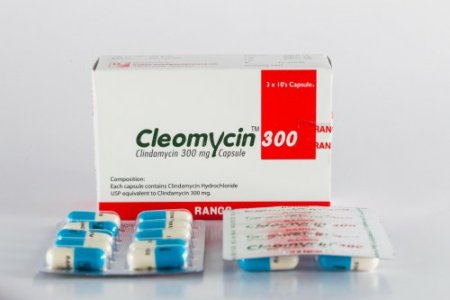
Type:Capsule
Generic Name:Clindamycin
Manufacturer:Rangs Pharmaceuticals Ltd.
Price:৳15.00
Dental infections, Respiratory tract infections, Skin and soft tissue infections, peritonitis, acne, anaerobic infections, endocarditis, Toxic shock syndrome, Bacterial vaginosis, Pelvic inflammatory disease
Cap: May be taken with or without food. Swallow whole w/ a full glass of water & in an upright position. Granules: Should be taken with food. IV Preparation Dilute 300 and 600 mg in 50 mL of D5W Dilute 900 mg in 50-100 mL of D5W Dilute 1200 mg in 100 mL of D5W IV Administration Intermittent IV infusion Infuse over 10-60 min at a rate not exceeding 30 mg/min 300 mg doses infuse over 10 min 600 mg doses infuse over 20 min 900 mg doses infuse over 30 min 1200 mg doses infuse over 60 min; no more than 1200 mg of drug should be given by IV infusion in 1 hr Continuous IV infusion May give continuous IV infusion instead of intermittent after first dose has been given by rapid IV infusion
Adult: PO Serious anaerobic infections 150-300 mg 6 hrly, up to 450 mg 6 hrly for severe infections. Max: 1.8 g/day. Prophylaxis of endocarditis 600 mg 1 hr before dental procedure. IV Serious anaerobic infections 0.6-2.7 g/day in divided does, up to 4.8 g/day for severe infections. Toxic shock syndrome W/ penicillin G or ceftriaxone: 900 mg 8 hrly. Pelvic inflammatory disease W/ gentamicin: 900 mg 8 hrly. Bacterial Vaginosis: 300 mg PO q12hr for 7 days
Neonates (less than 1 month): 15 to 20 mg/kg/day in 3 to 4 equal doses. The lower effective dosage may be adequate for small prematures. Child: PO 10–25 mg/kg/day q8h 30–40 mg/kg/day for CA-MRSA, intra-abdominal infection, or AOM Parenteral (IV/IM) administration: 20–40 mg/kg/day q8h. The higher doses would be used for more severe infections.
Hypersensitivity.
Clindamycin inhibits protein synthesis by reversibly binding to the 50S subunit of the ribosomal thus blocking the transpeptidation or translocation reactions of susceptible organisms resulting to stunted cell growth.
Renal and hepatic diseases; pregnancy and lactation; GI disease; elderly, females, neonates, atopic patients. Regular monitoring of blood counts, liver and kidney functions. Lactation: Excreted in breast milk; manufacturer suggests discontinue drug or do not nurse (AAP Committee states compatible with nursing)
Diarrhoea, nausea, vomiting, abdominal pain; erythema multiforme, contact dermatitis, exfoliative and vesiculous dermatitis, urticaria; eosinophilia; local irritation, thrombophloebitis. Potentially Fatal: Gasping syndrome (neonates); pseudomembranous colitis.
Pregnancy In clinical trials with pregnant women, systemic administration of clindamycin during the second and third trimesters, has not been associated with increased frequency of congenital abnormalities Clindamycin should be used during first trimester of pregnancy only if clearly needed; there are no adequate and well-controlled studies in pregnant women during first trimester of pregnancy. Because animal reproduction studies are not always predictive of the human response, this drug should be used during pregnancy only if clearly needed Lactation Clindamycin has been reported to appear in breast milk in range of 0.5 to 3.8 mcg/mL; clindamycin has potential to cause adverse effects on breastfed infant's gastrointestinal flora; if oral or intravenous clindamycin is required by nursing mother, it is not a reason to discontinue breastfeeding, but alternate drug may be preferred; monitor infant for possible adverse effects on gastrointestinal flora, such as diarrhea, candidiasis (thrush, diaper rash) or rarely, blood in stool indicating possible antibiotic-associated colitis The developmental and health benefits of breastfeeding should be considered along with mother's clinical need for clindamycin and any potential adverse effects on breastfed child from clindamycin or from underlying maternal condition
May enhance the action of neuromuscular blocking agents (e.g. atracurium). May antagonise the effects of parasympathomimetics. May competitively inhibit the effects of macrolides, ketolides, streptogramins, linezolid and chloramphenicol. Increased coagulation tests (prothrombin time/INR) and/or bleeding w/ vit K antagonists (e.g. warfarin, acenocoumarol, fluindione).